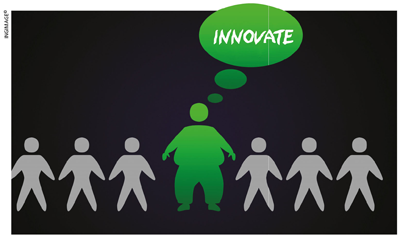COMPETITIVE ADVANTAGES
ALL-NEW INNOVATION TRAINING
Today’s innovation training needs a rethink – Dr. Muneer Muhamed explains
Businesses achieve success when a differentiated value proposition is offered to selected customer segments using unique value chains. Strategy experts call this a ‘competitive advantage’ to conquer the market.
Innovation guru Rita McGrath contributed to the art and science of strategy with her framework on transient competitive advantage for current times. To gain transient advantages, innovation is key; but this is not easy given Sri Lanka’s propensity for copy-and-paste and risk aversion.
To deliver on strategy, enterprises must understand customer needs. End user insights are critical to hit pay dirt with a new offering. But not many companies are too close to the end user. Innovation or new product development is unlikely to transpire without key insights.
There are examples galore for failed innovations sans insights and perhaps this is why companies resort to copy-and-paste what is successful elsewhere.
 Innovation management requires specialised training and existing methods need a rethink. Most innovation management training programmes miss the mark, and fail to reap the desired end results of quicker cycle times and improved new offering effectiveness solely due to a lack of user understanding.
Innovation management requires specialised training and existing methods need a rethink. Most innovation management training programmes miss the mark, and fail to reap the desired end results of quicker cycle times and improved new offering effectiveness solely due to a lack of user understanding.
When developing training programmes for internal new product participants, companies should adopt an ‘outside in’ approach to identify training needs and use this input to craft tailored training programmes.
Internal research must encompass internally perceived strengths and weaknesses of existing innovation processes and organisational structures; internal barriers affecting innovation success and effectiveness; check who benefits from training; assess perceived and real training needs; find out how innovation training bridges differences between perceived and real training needs; and identify the most appropriate format for innovation training (e.g. on or off-site, the number of days, and level and type of interaction) and effective methodologies in our culture.
To gather this information, individual interviews (or focus groups for large businesses) should be conducted. Likewise, attendance at innovation team and/or council meetings is important. A review of relevant internal information including team meeting notes and new product process or performance documents is also necessary.
In addition to gathering internal customer perceptions of training requirements, test marketing the resulting programme with a pilot group of ‘innovation participants’ can help gauge its effectiveness and fine-tune the programme before it is rolled out.
Some clients believe that only team leaders need training. But new product development barriers cannot be overcome with team leader training alone.
Broadly speaking, there are three barriers vis-à-vis the team leader (e.g. suboptimal communication, unrealistic expectations and new people with little training or experience); the team (inconsistent understanding of new product development processes, inconsistency among projects – no two projects are conducted in the same way – inadequate team motivation and unclear expectations); and interdepartmental obstacles (insufficient resources, low visibility for new products and interdepartmental conflicts).
Within teams and across departments, communication and expectations need to be fortified. One way to do this is to train team leaders on project management and motivation skills. Another is to help jumpstart a team with a two day kickoff meeting. The most effective route is a six month programme that works with innovation teams of new projects with multiple levels of handholding, and internal and external reviews.
The objectives of training must be decided at the outset – for instance, developing a team mission and success criteria; establishing a common language among team members along with company norms, values and ground rules; building team spirit; increasing team members’ ability to manage and motivate; clarifying each team member’s role and responsibilities; and providing actionable guidelines for managing new product development.
To identify workshop expectations and gain a better understanding of each participant’s frame of reference, team members must be surveyed before a session to gauge their experience in new product development and innovation. They should be probed on what they believe their team roles are and what they want to accomplish at the workshop. Use this input to fine-tune the workshop material; but more importantly, build ownership. Post-session reviews must further refine additional sessions.
Such training sessions help innovation team members solidify their sense of commitment and belonging to the team instead of their respective departments. From a management perspective, team identity and cohesiveness are expected to reduce cycle time by pre-empting interdepartmental barriers and conflicts.
Few innovation heads follow a customer driven process to develop and conduct internal training sessions. Yet, giving participants what they want is a great starting point to ensure a better ROI for innovation training.





Training will be most effective if clubbed with actual projects. We have done a six month programme with five project teams on new initiatives to let the company decide which ones should be supported for its future growth. Given the ideas in this article, I am positive that more could be accomplished with customer centric insights.
Insightful article! We have to embrace proper training for driving innovation in this country, whether it is business or government!
A most refreshing viewpoint for companies in Asia. We lack the innovation that made developed nations what they are today. We seem to be copying and pasting what has been successful elsewhere. Uberisation is a word and phrase we popularised. The suggestions by the columnist seem practical and I wonder if the author or his company provides any services in this regard.
Transient competitive advantage, innovation pilot groups, outside-in perspective with customer focus, and interaction between external stakeholders and internal participants with a defined objective etc., are great thoughts that this article highlighted! Great article by Dr. Muneer Muhamed, a leading Strategy & Balanced Scorecard Guru!